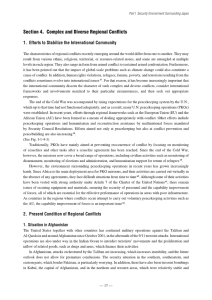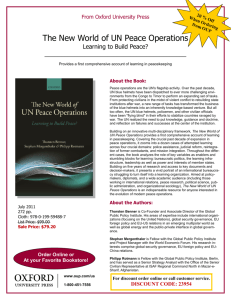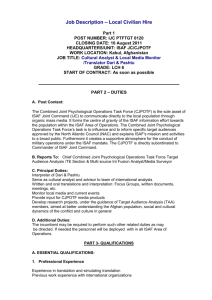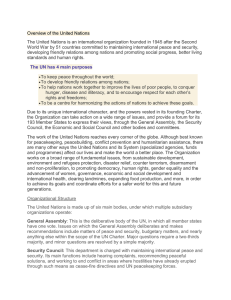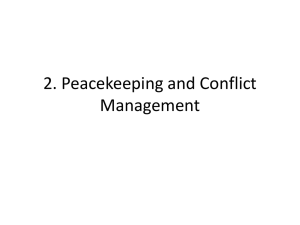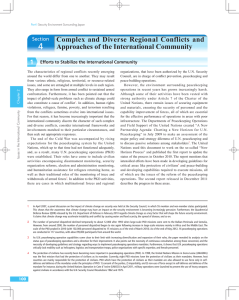1 Efforts to Stabilize the International Community Cha pt
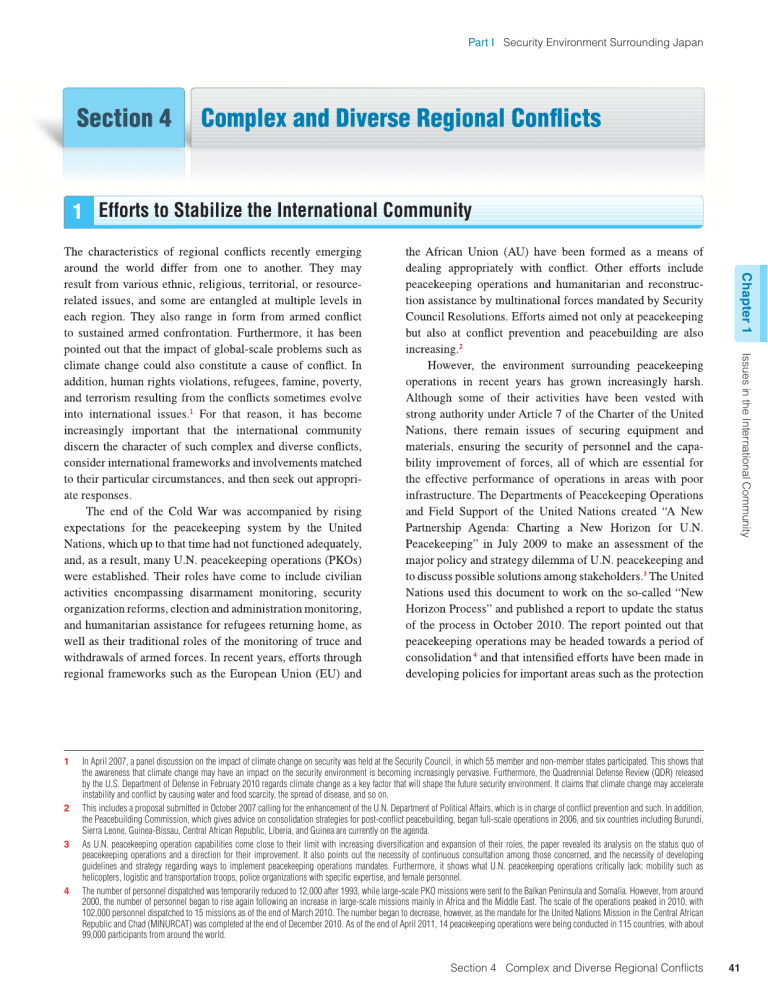
1
Efforts to Stabilize the International Community
Part I Security Environment Surrounding Japan
1 In April 2007, a panel discussion on the impact of climate change on security was held at the Security Council, in which 55 member and non-member states participated. This shows that the awareness that climate change may have an impact on the security environment is becoming increasingly pervasive. Furthermore, the Quadrennial Defense Review (QDR) released by the U.S. Department of Defense in February 2010 regards climate change as a key factor that will shape the future security environment. It claims that climate change may accelerate instability and conflict by causing water and food scarcity, the spread of disease, and so on.
2 This includes a proposal submitted in October 2007 calling for the enhancement of the U.N. Department of Political Affairs, which is in charge of conflict prevention and such. In addition, the Peacebuilding Commission, which gives advice on consolidation strategies for post-conflict peacebuilding, began full-scale operations in 2006, and six countries including Burundi,
Sierra Leone, Guinea-Bissau, Central African Republic, Liberia, and Guinea are currently on the agenda.
3 As U.N. peacekeeping operation capabilities come close to their limit with increasing diversification and expansion of their roles, the paper revealed its analysis on the status quo of peacekeeping operations and a direction for their improvement. It also points out the necessity of continuous consultation among those concerned, and the necessity of developing guidelines and strategy regarding ways to implement peacekeeping operations mandates. Furthermore, it shows what U.N. peacekeeping operations critically lack; mobility such as helicopters, logistic and transportation troops, police organizations with specific expertise, and female personnel.
4 The number of personnel dispatched was temporarily reduced to 12,000 after 1993, while large-scale PKO missions were sent to the Balkan Peninsula and Somalia. However, from around
2000, the number of personnel began to rise again following an increase in large-scale missions mainly in Africa and the Middle East. The scale of the operations peaked in 2010, with
102,000 personnel dispatched to 15 missions as of the end of March 2010. The number began to decrease, however, as the mandate for the United Nations Mission in the Central African
Republic and Chad (MINURCAT) was completed at the end of December 2010. As of the end of April 2011, 14 peacekeeping operations were being conducted in 115 countries, with about
99,000 participants from around the world.
Section 4 Complex and Diverse Regional Conflicts 41
Part I Security Environment Surrounding Japan
Fig. I-1-4-1
List of Presently Operating Peacekeeping Operations
Note: According to the United Nations (as of the end of May 2011)
Africa
Mission
United Nations Mission for the Referendum in
Western Sahara (MINURSO)
United Nations Mission in Liberia (UNMIL)
United Nations Operation in Côte d’lvoire
(UNOCI)
United Nations Mission in Sudan (UNMIS)
African Union/United Nations Hybrid Operation in Darfur (UNAMID)
United Nations Organization Stabilization
Mission in the Democratic Republic of the
Congo (MONUSCO)
Established Date
1991. 4
2003. 9
2004. 4
2005. 3
2007. 7
2010. 7
Middle East
Mission
United Nations Truce Supervision Organization
(UNTSO)
United Nations Disengagement Observer Force
(UNDOF)
United Nations Interim Force in Lebanon
(UNIFIL)
Established Date
1948. 5
1974. 6
1978. 3
Asia
Mission
United Nations Military Observer Group in India and Pakistan (UNMOGIP)
United Nations Integrated Mission in Timor
Leste (UNMIT)
Established Date
1949. 1
2006. 8
Europe/CIS
Mission
United Nations Peacekeeping Force in Cyprus
(UNFICYP)
United Nations Interim Administration Mission in Kosovo (UNMIK)
Established Date
1964. 3
1999. 6
The Americas
Mission
United Nations Stabilization Mission in Haiti
(MINUSTAH)
Established Date
2004. 6
42 Section 4 Complex and Diverse Regional Conflicts
2
Present Condition of Regional Conflicts
1
Situation in Afghanistan
Part I Security Environment Surrounding Japan
-5 The protection of civilians has recently been getting more important in peacekeeping operations. For instance, President Gbagbo of Cote d’Ivoire, who did not accept the election results as of November 2010 and refused to step down from his presidency, attacked the supporters of former Prime Minister Ouattara, the elected candidate verified by the international community, and the United Nations Operation in Cote d’Ivoire (UNOCI). In response to this incident, the U.N. Security Council adopted Resolution 1975 in March 2011 to confirm the authority of the UNOCI to implement all measures required to protect civilians including the prohibition of the use of heavy weapons against the civilians. Based on Resolutions 1975 and 1962, the UNOCI and the French forces stationed in Cote d’Ivoire launched an attack on bases, from which Gbagbo’s forces were using heavy weapons, in order to prevent their use against cilivians. Subsequently, President Gbagbo was detained by forces loyal to former Prime Minister Ouattara.
-1 Under U.N. Security Council Resolution 1386 (December 20, 2001), the International Security Assistance Force (ISAF) was approved to be established with the principal mission of maintaining security in Kabul and the surrounding areas. Based on U.N. Security Council Resolution 1510 (October 13, 2003), the ISAF has gradually expanded its area of deployment since December 2003. Since October 2006, the ISAF has been deployed throughout the entire territory of Afghanistan. The ISAF has set up the ISAF Joint Command, the NATO Training
Mission-Afghanistan, and the ISAF Special Operations Forces under the ISAF Headquarters in Kabul with six regional commands under the ISAF Joint Command, and provides support to the Afghan Government for the maintenance of security. As of June 2011, approximately 132,000 troops from 48 countries have been dispatched to the ISAF.
2 The Provincial Reconstruction Teams (PRTs) are designed to extend the authority of the Afghan Central Government across the country, and work to improve the security environment and implement reconstruction and development activities. The PRTs are comprised of military personnel and civilian reconstruction assistance personnel. As of June 2011, there are
28 teams active in various parts of the country.
3 The Afghan National Army has approximately 164,000 personnel as of June 2011, while the Afghan National Police has approximately 126,000 personnel as of June 2011. Furthermore, the goal is to expand these to approximately 172,000 and 134,000 members, respectively, by October 2011.
4 FATA as well as Quetta and Khyber Pakhtunkhwa Province of Pakistan have been pointed out as critical safe havens for Al-Qaeda, the Taliban, and others. U.S. Director of National
Intelligence (DNI), “Annual Threat Assessment (February 2010).”
Section 4 Complex and Diverse Regional Conflicts 43
Part I Security Environment Surrounding Japan
2
Situation in Iraq
3
Situation in the Middle East
44
5 In December 2010, the U.S. government published the overall evaluation of its strategy, which described that its strategy was functioning, and showed its intention to start the transition of responsibility for security to the Afghan Government at an early stage in 2011 and is setting the conditions to begin the responsible reduction of U.S. forces in July 2011.
6 At the NATO Defense Ministerial in June 2011, ISAF Commander General David Petraeus reported that due to progress against the insurgency, it would be possible to commence the transition of responsibility for security to Afghanistan in seven districts and provinces in July, as planned.
7 In January 2010, Multi-National Force-Iraq was transformed into United States Forces-Iraq.
8 In September 2010, the responsibility of the U.S. forces in Iraq made the transition from “Operation Iraqi Freedom (OIF)” to “Operation New Dawn,” shifting the emphasis to assisting and training Iraqi Security Forces and helping build Iraq’s civil capacity.
9 In November 2010 and in April 2011, then U.S. Secretary of Defense Robert Gates stated the U.S. willingness to discuss the continued presence of U.S. troops in Iraq in/after 2011 given requests by Iraq.
Section 4 Complex and Diverse Regional Conflicts
Part I Security Environment Surrounding Japan
5
Situation in Libya
4
Situation in Syria
10 In May 2011, Fatah and Hamas reached a reconciliation agreement including the formation of a joint interim government.
11 Military observers of the United Nations Truce Supervision Organization (UNTSO) are also active within this region.
12 Ibid.
13 The tension along the border between Israel and Lebanon has occasionally been heightened with incidents such as the one that took place in August 2010, where troops from both sides initiated exchange of fire on a limited scale at border areas and caused casualties. However, the situation has not been aggravated.
14 It is against this backdrop that in May and June 2011 protestors supporting Palestine and opposing Israel tried to cross to the Israel-controlled Golan Heights from the Syrian border, clashing with Israeli forces and causing casualties.
15 In April 2011, U.S. President Barack Obama signed an Executive Order imposing sanctions against individuals and entities that have engaged in human rights abuses in Syria including those related to the repression of demonstrations. The measures include an assets freeze in the United States of the targeted, and prohibiting U.S. persons from engaging in transactions with them (the scope of sanctions was expanded in May 2011). The EU adopted a decision in May 2011 providing for an embargo on exports to Syria of arms and equipment that could be used for repression, as well as a visa ban and an assets freeze targeting officials and associates of the Syrian regime responsible for violent repression against the civilian population in
Syria. Furthermore, the United Nations Human Rights Council held a special session in April 2011 and adopted a resolution on the human rights situation in Syria which, above all, urges the Syrian Government to immediately put an end to all human rights violations.
16 “NATO and Libya: Operational Media Update”
17 Initially the United States Africa Command, one of the Unified Combatant Commands of the U.S. Armed Forces, commanded and controlled the multinational forces. After the authority was transferred to NATO, the Allied Joint Force Command located in Naples, Italy, has commanded and controlled the Allied Air Command in Izmir, Turkey, and the Allied Maritime Command in Naples.
Section 4 Complex and Diverse Regional Conflicts 45
Part I Security Environment Surrounding Japan
6
Situation in Sudan
46
18 The military operations by NATO are called “Operation Unified Protector,” participated by Belgium, Bulgaria, Canada, Denmark, France, Greece, Italy, the Netherlands, Norway, Qatar,
Romania, Spain, Sweden, Turkey, the United Arab Emirates, the United Kingdom, and the United States as of April 5, 2011. On the other hand, the European Union (EU) in April 2011 decided to establish the EU Libya mission (EUFOR Libya) and to implement military operations for humanitarian assistance in Libya, if there is any request from the United Nations.
19 The Libya Contact Group is designed to: 1) give leadership and comprehensive political guideline to international initiatives to assist Libya, 2) provide opportunities to discuss and coordinate international efforts for Libya, and 3) provide a central forum in the international community to contact Libya. The first meeting was held in Qatar in April 2011, which resulted in the agreement to establish a framework to manage funds required to assist Libyan citizens. In May 2011, the second meeting was held in Italy at which it was decided to establish the
Libyan Information Exchange Mechanism which can be used to help identify and coordinate in-kind requirements of the Transitional National Council. The third meeting was held in the
United Arab Emirates in June 2011.
20 At the end of April 2011, the mandate of the UNMIS was extended until July 9, 2011, which is the expiration date of the CPA through Security Council Resolution 1978. In a report to the
Security Council in May 2011, the U.N. Secretary-General recommended the establishment of a new PKO mission, the main tasks of which would be good offices and political support for peace consolidation in South Sudan, as well as support to security sector reforms and the rule of law, and security aspects, including conflict mitigation and physical protection of civilians.
21 The Abyei Area was a site of fierce fighting during the North-South conflict. Both the North and the South assert dominion over the area abundant in oil resources. The question over its territorial rights was to be settled via a referendum in January 2011, which has not yet been held. The territorial rights issue is still undecided. The tension continued as the North Sudan
Armed Forces (SAF) invaded and took control of the area in May 2011. In June 2011, the Security Council established through Resolution 1990 the United Nations Interim Security Force for Abyei (UNISFA) in the region.
22 As the referendum in Southern Sudan has been held peacefully, the United States is considering removing Sudan from its State Sponsors of Terrorism list.
Section 4 Complex and Diverse Regional Conflicts
Part I Security Environment Surrounding Japan
8
Situation in Haiti
7
Situation in Somalia
23 Major challenges still facing the region include the demarcation of the north-south border including the status of the disputed areas of Abyei as well as issues related to citizenship.
Furthermore, post-CPA issues encompass oil profit distribution between the North and the South, currency, distribution of debts and assets, and water rights of the Nile.
24 In January 2011, the JEM and another anti-government group, the Liberation and Justice Movement (LJM), issued a joint statement to work together on moving the Darfur peace process forward, showing a sign of certain progress.
25 In August 2010, anti-government forces attacked a hotel in the capital of Mogadishu, killing more than 30 people including parliamentarians.
26 According to the International Maritime Bureau (IMB), there were 219 cases of piracy by Somali pirates in 2010 (53 in the Gulf of Aden, 139 along the Somali coast, 25 in the Red Sea, and
2 in the Arabian Sea).
27 U.N. Security Council Resolution 1542 (adopted in April 2004).
28 U.N. Security Council Resolution 1908 (adopted in January 2010).
29 The United Nations Office for the Coordination of Humanitarian Affairs reported a total of 216,000 infected patients and the death toll at 4,131 as of February 2011.
Section 4 Complex and Diverse Regional Conflicts 47
Part I Security Environment Surrounding Japan
9
Situation in Timor-Leste
VOICE
VOICE
COMMENTARY
COMMENTARY
Q&A
Q&A
48
30 The mandate was extended based on U.N. Security Council Resolution 1969 (February 2011). A total of 1,280 people from 39 countries have been dispatched in accordance with the mandate as of the end of May 2011.
Section 4 Complex and Diverse Regional Conflicts
